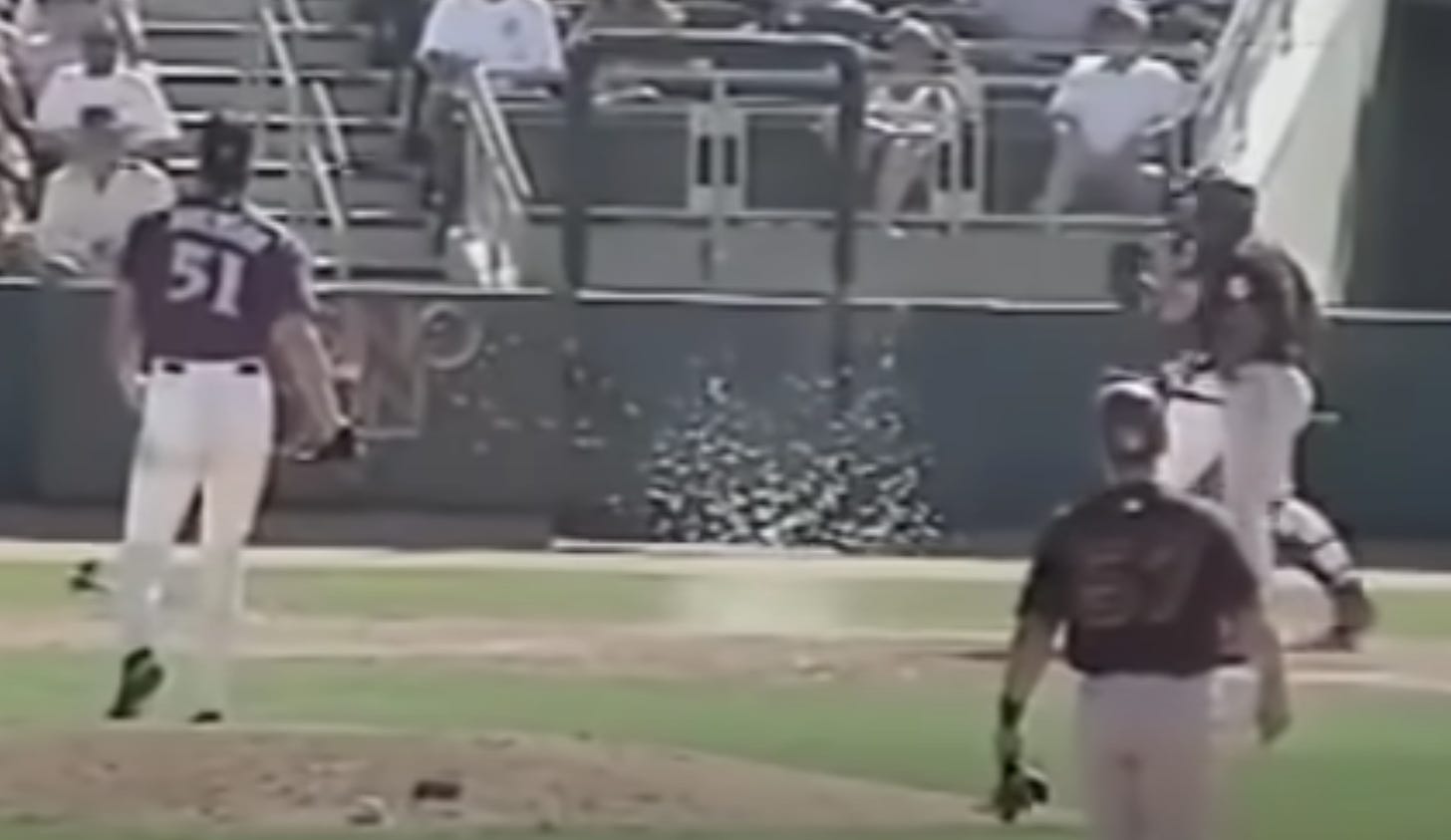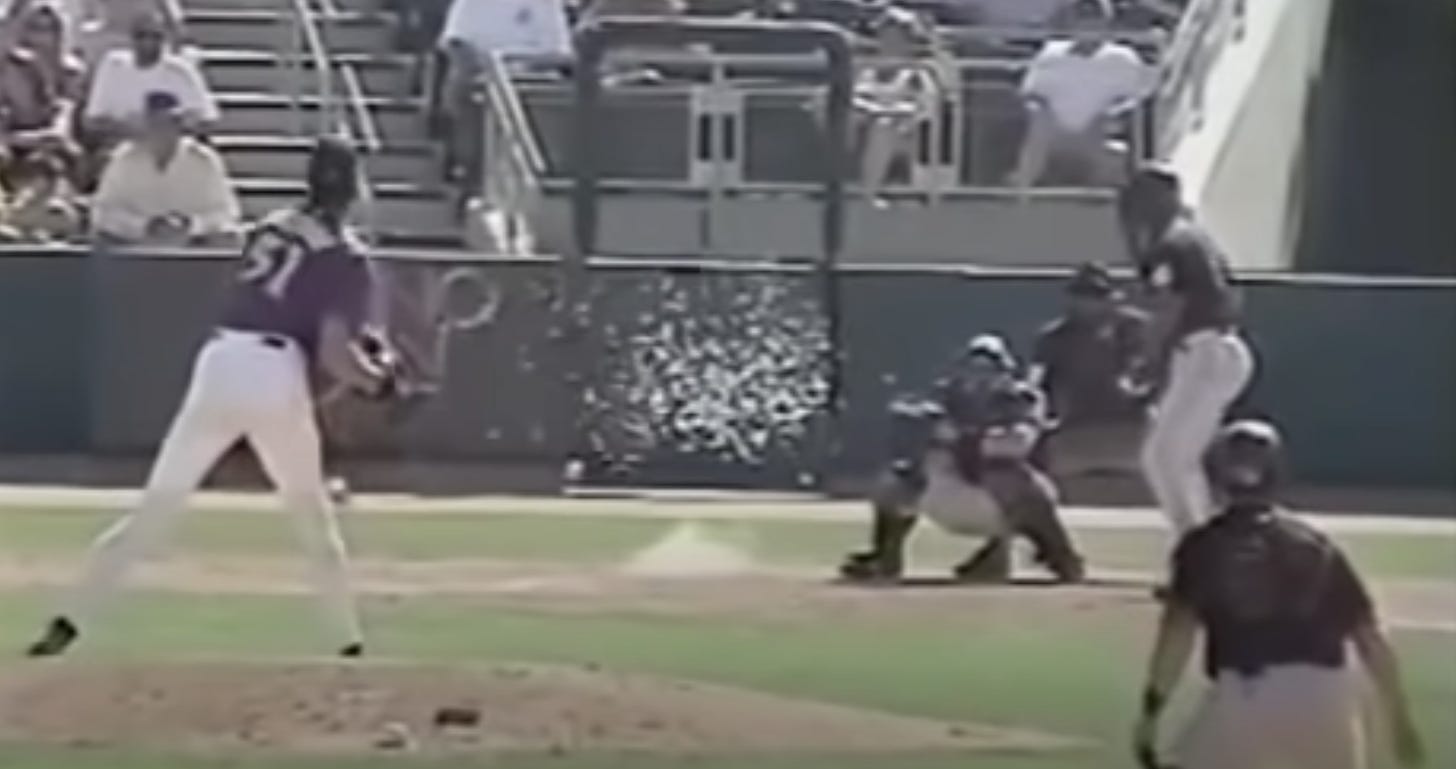Installment Three: Randy Johnson smoked that bird.
Since the advent of video broadcasts, every generation of baseball gets one most indelible moving image, a clip that is replayed until it has driven a thick groove into each of our brains. The first 20 years of televised baseball produced the Willie Mays catch. The next 20 years produced the Carlton Fisk stay-fair homer. Then Kirk Gibson, limping around the bases in the World Series. And, finally, the most recent addition to the permanent collection: Randy Johnson smoking a bird.
Mays’ Catch is primarily about athletic greatness. Fisk’s Wave is about suspense. Gibson’s Limp is about surprise. These are relatively simple stories. At most, you might watch those clips twice in a row. Randy Johnson KILLS BIRD With Fastball is not simple at all. At minimum, you watch it five times in a row. At minimum, once you’ve seen it, you share it with five other people. It’s beguiling.
Book 1: Randy Johnson Hit A Bird With A Pitch
Randy Johnson, pitching from the stretch, kicks his leg, drives toward home and pitches. His pitch and a bird briefly share space, producing a fusion-like explosion of birdstuff. As the grounded bird flaps one wing three final times, Johnson takes a step at it, as though he thinks the bird is going to get up and fight him and Johnson is showing he will not back down. He straightens up to his full height, which is considerable.
Randy Johnson was one of the most intimidating pitchers in history, and one of the tallest, which had both practical significance (he released the ball closer to the plate and at a more extreme left-to-right angle than shorter-armed pitchers) and visual significance (“Goliath’s height was six cubits and a span”).
Before and after this pitch, in March 2001, he was an all-time great. My favorite Randy Johnson achievement has always been his extraordinary climb up the career WAR leaderboards, starting relatively late in his career. Through age 25, before he harnessed his control, he had produced 0.1 Wins Above Replacement, and through age 28—an age by which many pitchers are already washed up—he had 7.6 WAR. That’s not bad. He’d been an All-Star once. He’d won more games (49) than he’d lost. Only 1,003 pitchers in history produced more than 7.6 WAR through age 28. So, basically, through age 28, he was the 1,000th best pitcher who ever lived, an amazing thing. Among the greatest Randies of all-time. He was no Randy Wolf or Randy Jones or Randy Myers, but he was at least tied with Randy Wells, the fourth-best Randy.
And then he got serious. Through age 29, Randy Johnson had the 535th most WAR by a pitcher ever. There had been 1,000 pitchers in history better than him when he was 28, and in a single season he chopped half of them down. He kept chopping, passing all-time greats like they were standing still:
Through age 30: 355th most WAR in history
Through age 31: 206th most WAR in history, won first Cy Young award
Through age 32: 218th
Through age 33: 148th
Through age 34: 117th
Through age 35: 68th
Through age 36: 50th
Through age 37: 28th most WAR in history, hit first bird
Through age 38: 18th most WAR in history, won fifth Cy Young
Through age 39: 18th
Through age 40: 11th
He would end up ranked ninth in history in WAR. He was one of perhaps five pitchers (along with Roger Clemens, Pedro Martinez, Greg Maddux and Walter Johnson) who has a case for being called the greatest AL/NL pitcher of all time. He did much of it while he was old, which just enhances the singularity of his career. As does his height. As does his hair. As does his disposition. As does, of course, his incredible fastball.
But before the bird he didn’t have a one-line description of his greatness. Everything else either takes too long (like what I just did with the WAR-through-age bulletpoints), or just drives everybody into a debate (like what I did with my five plausible greatest pitchers). The bird explosion is the mic-drop moment. It gave Randy Johnson his signature visual.
***
A truthful assessment would conclude there was nothing exceptional about the pitch he threw that day.
Johnson’s bird-killer was described in various game stories as 95 mph or 97 mph. Perhaps the pitch was actually clocked, or perhaps the writers were giving estimates based on Johnson’s usual velocity. Johnson could top 100 mph, but it’s extremely unlikely he was doing so in the seventh inning of a spring training game. Maybe it was actually 94, maybe it was actually 98. Well, in the year 2022, the average major league fastball was 94 mph, and more than 10,000 pitches were thrown 98 mph or harder. Some 500 pitches last year were thrown 101 mph or harder, and that’s just the big leagues. Similar velocities are common at all levels of the minors. If there was a strong correlation between pitch velocity and bird death, such that Randy Johnson’s extreme speed was the significant variable in the collision of baseball and bird flesh, then all those 101s would certainly kill a few birds a year.
They don’t1.
Fine, but Johnson’s fastball didn’t just hit the bird; it put an M-80 into the bird. It sent birdsmoke everywhere. It’s the perfect visual encapsulation of his velocity, and that’s why we love it. In a piece for Newsweek, Douglas Main talked to ornithologists. They explained that mourning doves have very loose feathers as an adaptive feature. When a diving predator is after them, a mourning dove can quickly release a cloud of feathers to escape. This is called a “fright molt.” Asked how fast a pitch would have to be going to produce this effect, researcher Henry Streby told Main “probably not that fast. The feathers you see exploding from the bird in the video are the downy feathers that cover the bird's body. Those feathers tend to come out much more easily than the larger stronger tail and wing feathers. I'm sure a casual home run derby pitch would make a similar scene if it hit the same bird.”
Which means that Randy Johnson’s fastball’s role in the event is physically, mathematically, practically, insignificant.
And yet Randy Johnson being Randy Johnson is the most important part of that video, equal to that of the bird being a bird instead of a hot dog wrapper. A YouTube commenter writes, “If that was his only major league pitch, he would still belong in the HoF.” This is a sincerely held belief, but it is exactly wrong. The video doesn’t make Randy Johnson; Randy Johnson makes the video. A junior high fastball could have made that bird go POOF!, but only two decades of extraordinary, terrifying pitching could give symbolic value to that POOF.
There was a minor league pitcher who hit a bird in 2014. The pitcher’s name was Jon Maciel; the bird was a swallow. It was also captured on video. One day, I told my dad about the Randy Johnson pitch. We discussed its significance. We argued about some interpretations of it. We watched it over and over. And then I mentioned Jon Maciel.
My dad was not even interested in seeing it. Jon Maciel hadn’t done the work.
Book 2. A Bird Hit A Pitch As A God
It was just another day doing errands, traveling the same three or four routes that made up 90 percent of life. Looking for seeds to eat. This is normal, the bird thought, the only thing it ever thought.
Keep reading with a 7-day free trial
Subscribe to Pebble Hunting to keep reading this post and get 7 days of free access to the full post archives.






